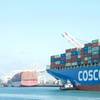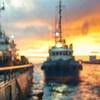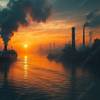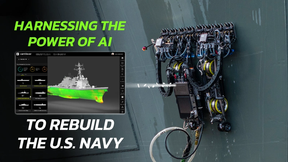The (Greener) Waterfront: A Fresh Perspective
MarineNews Editor Joseph Keefe weighs in with a look at the previous five years on the waterfront. It’s not what you think.
You might be aware that I stepped away for a moment in late December 2019. The five years that followed, whizzed right by – well, all but that miserable part of being virtually locked in my house for six months during “the Pandemic.” Enough said. Now back in the Editor’s chair here at MarineNews magazine, it is apparent that while some things on the collective waterfront have changed, many things have not.
The marine industry’s focus on achieving a greener operating footprint marches on. In fact, that effort has picked up a lot steam. All that said; you might be justified in being skeptical to take advice from someone who has been admittedly out of the game for a while. Rest assured; I’ve been watching closely from the cheap seats. I’m not from the government, but I am here to help.
In September of 2019, about two months before I retired for the first time, I found myself sitting in a hotel room in Namibia, killing time between the end of one safari, and the beginning of another. With nothing better to do, I turned on the TV and had the misfortune to hear Greta’s famous speech at the UN Climate summit. Listening in, you’d have thought that we’d collectively done nothing in the past half century to improve the quality of life and habitability on planet earth. That said, I’m somewhat ashamed to admit that my first thoughts, after listening to a clueless 16-year-old chew out the world, included, “She’ll get my ten-year-old 3.5 HP Briggs & Stratton lawnmower when she pries it from my cold dead hands.”
Nevertheless, it is a moment like the one described above that prompts one to thinking: Are we doing enough? Can we do more? And, if so, at what cost? From my seat, it is clear that it is the last part that should be driving the first. And, if that sounds like I’m not a solid environmentalist, then you should keep on reading.
The Cleanest Place on the Planet
I didn’t spend the last five years sitting on my hands. I did spend the better part of a ridiculous year in lock-down with everyone else, after being assured that I could travel, if I’d only get a couple of shots and wear a mask. That didn’t quite work out. Eventually, I escaped U.S. airspace on 20 October 2022 at 0237 AM for a long-planned but delayed hiking trip to Nepal. We (my wife and I) followed that with another (long delayed) adventure in Bolivia and Chile, and along the way, found time to visit Bonaire and Canada. In fact, I have spent time on at least four Continents in the past five years.
I don’t tell you all that to brag. Instead, I want to bring global perspective to the mistaken notion that the United States and – in microcosm – its maritime industry, is somewhat deficient in its efforts to “green up” the planet. As for being deficient, nothing could be further from the truth. Don’t let anyone else tell you different.
I happily say with great certainty, that the USA – adjusting and allowing for population density and being one of the globe’s largest ‘first world’ industrial powers – is the cleanest place on the planet. And, if you want definitive proof of that, all you need to do is step off a plane at LAX or Long Beach, CA and venture out into the nation’s largest port complex. Starting in the late 1980’s and throughout the 1990’s, I spent a great deal of time out there, providing ship vetting services, cargo surveys and myriad other similar tasks. Back then, the air was very bad; bad enough burn your eyes as soon as you stepped outside the terminal. What has happened since didn’t occur in a vacuum; nor by accident. Today, that air is some of the cleanest on the West Coast. Stay with me here.
A thousand different things have come together on the West Coast to create what we now see happening. Not the least of those variables involved the relentless and overly burdensome regulatory environment that West Coast maritime operators and marine ports endure on a daily basis. It starts with the little things: like replacing the concrete backweights on the container yard hustlers with batteries. It turns out those batteries are pretty heavy. Lo and behold, the battery was performing two functions, and the diesel yard hustlers went the way of the dinosaur.
Next came the “cold ironing,” or in other words, the shutting down of large vessel’s powerplants in favor of an electric plug-in alongside the pier. Sure enough, the procedure eliminated what was coming out of the stack and made for a cleaner port. Of course, back in its infancy, some of that electricity was being generated by powerplants situated elsewhere, burning – you guessed it – fuel oil. As I covered that story, I remarked to my interviewee, “Well, this is great in the port. But, all those little kids in the valley are still breathing bad air, no?” This was not well received. And, to be fair, California has since that time largely cleaned up its power plants and now burns, so I am told, a lot of natural gas. 90 percent less NOx, 85% less SOx; far less particulate matter. A ‘win-win’ for everyone.
Two Kinds of Green
Two decades ago, as the environmental lobby trained its sights on the waterfront, the maritime industry did its best to respond. But, in a business sector that tends to reflect a cyclical “boom and bust” rhythm, the money wasn’t always there. Soon, the carrot of rewarding “green operations” was born, or rather, being dangled mostly as lip service. Back then, an old friend from my Houston days, a top school MBA guy, was running some pretty big endowments for serious operators. We’ll call him “Jack.” I asked him, “Jack, do these green enhancements and efforts have any legs? I mean, can people really extract concessions and financial rewards for being environmentally friendly?” He replied, simply, “Unless a company is totally sure that ‘going green’ is going to make money, then 95% of the companies out there aren’t going to bite.” Back then, he was right.
The effort to green those ports has come at a cost. It has increased the cost of doing business and the ultimate cost to the consumer down the supply chain. Like an offshore oil rig, whose carbon footprint is measured by including each and every standby vessel that services it, West Coast ports are also similarly burdened, because the carbon footprint of an inland FTZ warehouse is considered part of “the port’s problem.” In response, the ports introduced electric trucks to make those drayage moves. They can’t go very far, and they can’t make too many trips before having to recharge, but it is all part of the total equation. And, there are hundreds of additional ways that the environmental impact of these maritime endeavors has been addressed – and alleviated.
We’re in a different space now. The environmentally friendly efforts of twenty years ago are, to a large extent, no longer optional. At the same time, the promise of – for example – better day rates for greener vessels haven’t yet become the rule, rather than the exception. That “two-tier” market is still emerging. We may yet get to the point where “green always produces more green,” but we certainly aren’t there yet.
Low Hanging Fruit and the Elusive Dream of Carbon Net Zero
Looking ahead, and just as importantly, in the rearview mirror, the task of improving the environment will most certainly become much more difficult. And, much more expensive. That’s not because there isn’t an incredible amount of innovation impacting this market. There is. At the very same time, all the low hanging fruit has been picked. The piece that remains to be solved involves the inexorable march towards what some would call our “carbon net zero” future.
I can remember, just five years ago, sitting in a trade event technical briefing that discussed how a particular vessel’s carbon footprint could be reduced by 5% here, 20% there, 10% for ultra-low Sulphur fuel, another 15% with scrubbers, another 12% using marine friendly, extra slick coatings to eliminate drag and marine growth on the hull, and software to regulate fuel use and balance engine use (15%). And, much, much more. I scribbled on my reporter’s pad furiously, as fast as I could, and then added up all the savings. It came to 135%. I briefly considered raising my hand to ask the obvious question, but everyone seemed so content and happy. So, I pondered in silence.
There Will Never Be Enough:
For the really hardcore environmental lobby, there will never be enough. Never. Similarly, the promise of financial success achieved on the backs of environmental improvements is only now just beginning to emerge. But, will its full potential be realized? That’s the six-million-dollar question. Especially in an era when regulatory requirements continue to move the goalposts. I wouldn’t count on it.
Finally, if anyone on the collective global waterfront – blue water, coastal, or inland – is hoping to get a pat on the back for the incredible achievements that we’ve seen over the past two or three decades in the maritime industry, then they will be sadly disappointed. That’s because, on a planet separated by first and third world countries, there are different priorities in play for different players. The playing field is therefore anything but even.
On the global stage, China would like to be treated as a first world economy for the purposes of trade advantages, but at the same time, hide behind the false veneer of a third world country, while burning more coal than ever before. At the same time, Hong Kong hasn’t moved down the world’s TEU volume list behind a bunch of mainland Chinese ports because they aren’t competitive. Instead, it is because they’re the only one in that sector that enforces strict environmental controls. And – we’ve said this before – that comes at a price.
On my hiking trip to Nepal, we spent a few nights in Katmandu. It is an enormous metropolis; busy, sprawling, and sporting about 100,000 tier ZERO motor bikes whizzing through the streets. Just 50 miles outside the city center, one of the most beautiful places on earth can be seen and experienced. At the same time, the air quality in Katmandu is some of the worst I've ever experienced. And, they have no intention or incentive do anything about it.
At home here in the USA, I am completing this article on my third day back in the saddle. Looking ahead, I’m hoping that I get to learn about all the good things coming down the pike, brought to market by countless entrepreneurs who are collectively improving the air that we breathe and the water that we drink, every day, a little at a time. We’re fortunate for all of that which has transpired to date on the waterfront, and beyond. And there is more to do. I know we’ll get there. Reach out and school me as to how at [email protected]. I promise to put pen to paper and give those efforts the light they deserve.
It is good to be back. It is nice to be asked. And, I’m flattered that Greg and John did just that. Onward.
**************
Joseph Keefe is the Editor of MarineNews magazine, and a 1980 graduate of the Massachusetts Maritime Academy. A licensed mariner, his career has spanned more than 40 years in the maritime, shipping and energy sectors. His work has been featured in more than 15 industry periodicals. Today, he contributes to all of the New Wave Media tiles, as needed.

















